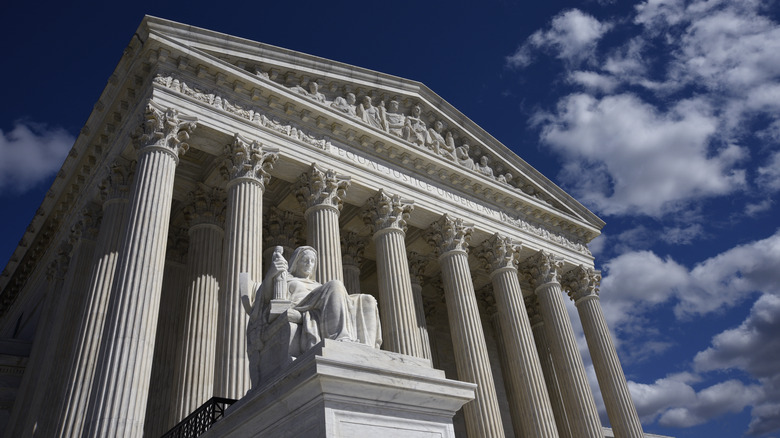The Closest A Supreme Court Justice Has Come To Being Assassinated
Presidential assassinations are often better remembered than targeted attacks on individuals from other branches of the federal government. But Congress and the judiciary have all faced threats on their lives, with no less serious implications. Attacks on legislators go back to 1868, and while no member of the Supreme Court has been killed by would-be assassins, there have been plots and close calls.
The only attack on a Supreme Court justice that ended with a physical confrontation concerned Associate Justice Stephen Johnson Field. According to PBS, the legislator made a long list of enemies during his life. Field was, his foes claimed, a small-minded and vain man, and he allegedly went about armed with two pistols (per Seton Hall University). Nevertheless, Abraham Lincoln appointed him to the Supreme Court in 1863, where his legal rulings favored powerful business interests over individual citizens.
Field earlier served on the California Supreme Court alongside one David Terry. Per the California Supreme Court Historical Society, the two men hated each other, and Terry later fought with Field in another court over remarks made about Terry's wife. On August 14, 1899, the Terrys chanced to be on the same train as Field. Terry began assaulting Field, despite repeated warnings from the justice's bodyguard. According to the ABA Journal, the guard believed Terry may have been reaching for a knife and shot him dead. Legal action against the guard went as high as the Supreme Court — but ultimately failed.
A lawyer-turned-murderer kept a dossier on Sonia Sotomayor
In 2020, U.S. District Judge Esther Salas was in her home in New Jersey when she, her husband, and her son were attacked by a gunman dressed as a delivery driver (per AP). Salas, who was in the basement, escaped injury, but her husband was critically wounded, and their son, Daniel Salas, was killed. The shooter was Roy Den Hollander, a lawyer with a reputation for frivolous lawsuits related to men's rights. According to The New York Times, Hollander described himself as "anti-feminist. The outlet also noted that Salas presided over his case concerning the male-only draft, and he "openly seethed against" her at the time. He went on to self-publish a book about his life, which included a racially-tinged online screed against the justice. Shortly before the shooting, Hollander was diagnosed with terminal cancer; authorities found his body in New York, about two hours from Salas' house, dead from a self-inflicted gunshot wound.
Hollander's book ended with a lament that he didn't have time to get even with all his perceived enemies. He's since been connected with the killing of Marc Angelucci, a California-based lawyer who was shot only days before the attack on the Salases (per the Los Angeles Times). And in 2021, Salas revealed to "60 Minutes" that the FBI had found a dossier among Hollander's private effects, which included more guns and ammunition (via CBS News). The dossier appeared to list potential targets, including Supreme Court Justice Sonia Sotomayor. "Who knows what could have happened?" Salas asked rhetorically.
Brett Kavanaugh's would-be attacker planned to go after other justices
After the death of her son, Judge Esther Salas championed legislation to take the personal information of judges off the internet as a security measure. Per CBS News, federal judges faced a 400% increase in death threats from 2016 to 2021. However, in the case of Senior District Court Judge James Robart, investigators found that a significant portion of these threats came from Russia — not American citizens. Roy Den Hollander's antagonism toward Supreme Court Justice Sonia Sotomayor never went beyond the dossier he kept on her, but in 2022, another man attempted to carry out the assassination of one of her colleagues.
According to CNN, Nicholas Roske was a young man upset about the leaked draft of the Dobbs ruling that overturned Roe v. Wade. Seeking purpose in life, Roske decided to kill at least one Supreme Court justice — and possibly three — to change the ideological makeup of the court. He researched assassination methods and equipment and armed himself with a gun and tactical knife. He set his sights specifically on Justice Brett Kavanaugh, whom Roske felt could potentially weaken gun control.
Roske shared his plans via Discord and traveled to Maryland with the intent of killing Kavanaugh and then himself. He got as far as the justice's home when his sister, via text, talked him down. Roske, who remains in custody awaiting trial as of September 2023, turned himself in, though he pled not guilty to attempted assassination charges, The Washington Post reported.


